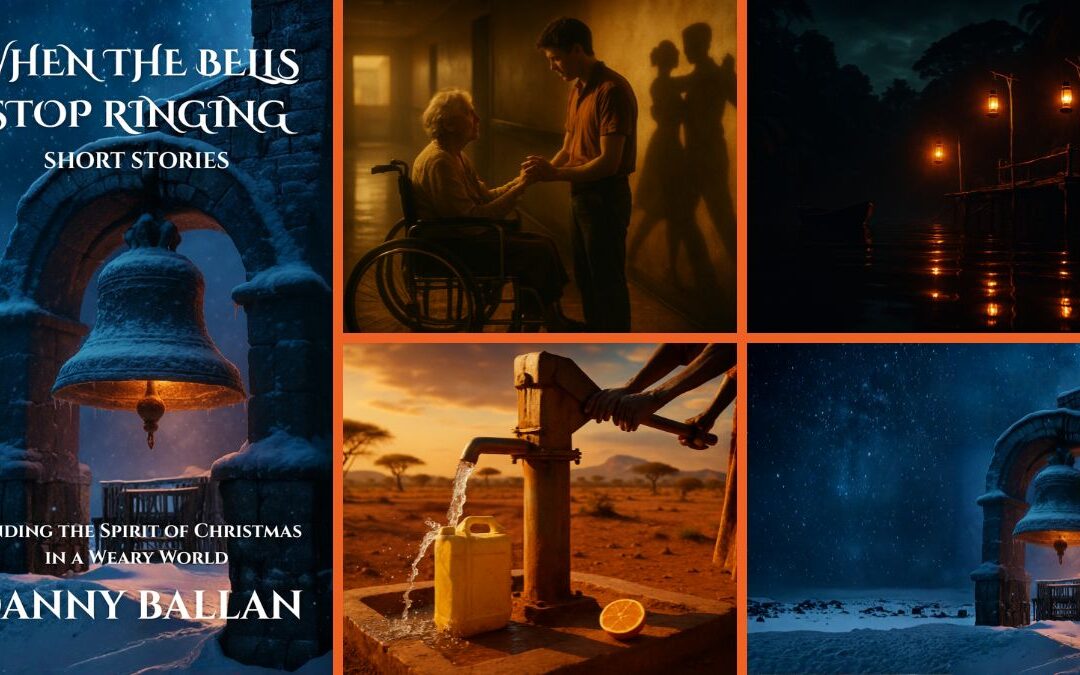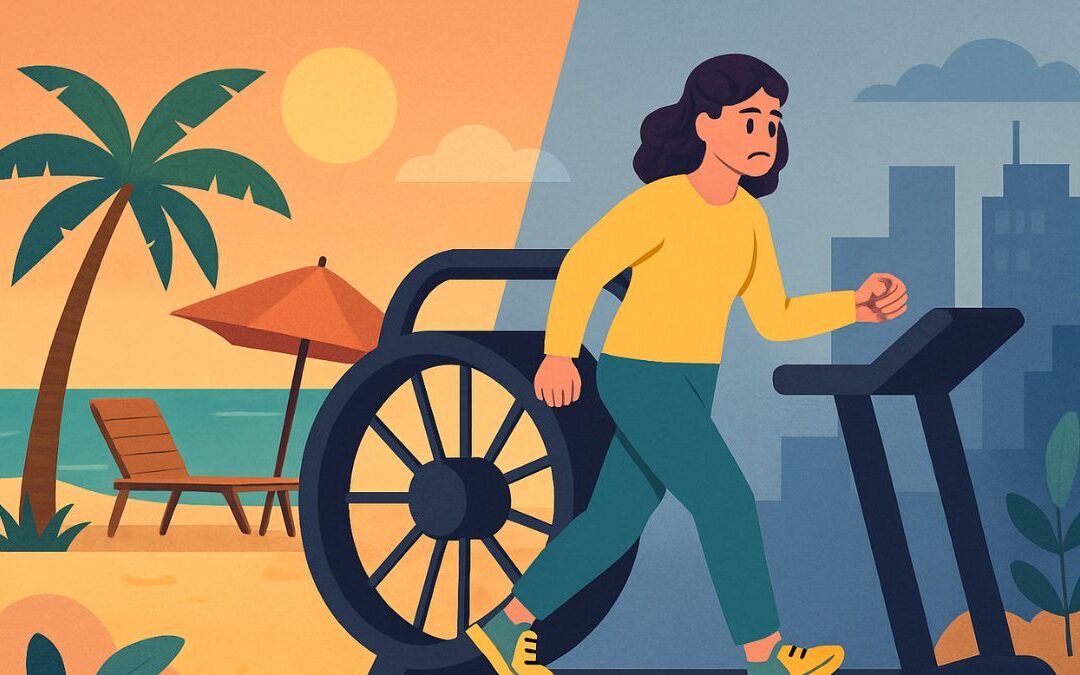Introduction
Hello, and welcome back to English Plus and our special series, Mind Matters. Last episode, we laid the groundwork. We talked about the brain as a biological organ and argued for a unified view of brain health, dismantling the artificial wall between the neurological and the mental. We talked in concepts, in theories, in broad strokes. Today, we do something different. Today, we make it personal.
Because it’s one thing to understand an idea intellectually, and another thing entirely to understand it viscerally, to feel its weight in your bones. Stigma, for instance, is an abstract concept until you are the one on the receiving end of a thoughtless comment. Brain fog is just a clinical term until it’s the impenetrable mist standing between you and a simple decision.
So today, we’re telling a story. We’re going to step out of the lecture hall and into the life of one person. We’re going to meet Sarah, a talented, ambitious professional who is, by all external measures, a success. She has a great job, she’s respected by her peers, she delivers high-quality work. But behind the composed facade, behind the polite smile and the focused gaze, Sarah is fighting a war. It’s a quiet war, fought entirely within the landscape of her own mind, against the twin specters of chronic depression and anxiety.
Her story is a window into the lived experience of what is often called a “high-functioning” brain disorder. And it begs us to ask some profound and uncomfortable questions:
- What is the true cognitive cost of “appearing normal”? How much energy, how much focus, how much sheer force of will does it take to perform wellness when your own mind feels like an adversary?
- How does the modern workplace, with its relentless emphasis on positivity, collaboration, and “can-do” attitudes, inadvertently become a hostile environment for someone navigating an invisible illness?
- Why do seemingly innocuous, even well-intentioned, phrases—”Just cheer up,” “Look on the bright side,” “We need you to be a team player”—have the power to be so utterly devastating?
- And finally, when you are trapped in the suffocating isolation that stigma creates, what does it actually take to break the silence? What does that first, terrifying step toward seeking help really look like?
The story you are about to hear, “Sarah’s Silence,” is a work of fiction. Sarah is not a real person. And yet, her experience is profoundly real, reflecting the daily reality of millions. This story is not a shortcut to understanding; no single narrative could ever encapsulate the sheer diversity of human experience with brain disorders. Instead, consider this an exercise in empathy. It’s an invitation to walk a mile in someone else’s shoes—shoes that may look perfectly fine on the outside, but are filled with invisible stones.
This is our Edustory. This is Sarah’s Silence.
Edustory: Sarah’s Silence
Hello again, and welcome to the second episode of our Mind Matters week. In our last conversation, we established that brain disorders are a matter of biology, not a failure of character. Today, we’re going to explore the human consequence of a world that hasn’t fully grasped that fact. We’re going to see how stigma, misunderstanding, and the pressure to conform can create an invisible prison. We’re going to do this through a story. An Edustory. Let’s meet Sarah.
Part 1: The Weight of Morning
The alarm on Sarah’s phone didn’t so much wake her as summon her from a great and murky depth. For a few blissful seconds, there was nothing. Just the gentle gray light filtering through the blinds. And then, it arrived. Not as a thought, but as a feeling. A physical sensation. A heavy blanket, woven from lead and ash, settling over her entire body. Depression. Her unwelcome, and most constant, companion.
Okay. Up. Just… sit up.
The command echoed in the cavern of her mind, but her body refused to obey. It was as if the signals from her brain had to travel through thick molasses to reach her limbs. She could hear the faint sounds of the city waking up outside her apartment window—a distant siren, the rumble of a garbage truck. The world was moving, and she was anchored to the mattress by an invisible gravity.
You’re going to be late. Mark will notice. You have that Apollo Project meeting at ten. You can’t be late for that one.
The voice of anxiety, Depression’s shrill and frantic cousin, finally did the trick. Fear was a more potent motivator than will. With a monumental effort, a groan that was part physical, part existential, Sarah swung her legs over the side of the bed. She sat there for a full minute, her head in her hands, the metaphorical blanket still clinging to her shoulders.
The bathroom mirror was not a friend. The woman looking back at her seemed like a stranger. Her eyes, usually a bright, intelligent green, were dull, clouded by a weariness that had nothing to do with lack of sleep. It was a soul-deep exhaustion. She saw the faint lines of worry etched around her mouth.
You look tired. You look like a fraud. They’re going to see right through you today.
Shut up, she thought, but the voice just chuckled.
The routine was automatic, a series of memorized movements. Brush teeth. Wash face. Apply concealer, a little extra under the eyes. A touch of mascara to feign alertness. A sweep of blush to mimic life. This was the first part of her workday: constructing the mask. The Sarah who was fine. The Sarah who was “on.” The Sarah who was not currently being crushed by the weight of her own consciousness.
Choosing an outfit was another battle. Not of fashion, but of energy. The black trousers and silk blouse were professional, easy. They required no thought. Thought was a precious, finite resource, and she had to conserve every drop for the day ahead.
Down in the kitchen, the coffee maker presented a bafflingly complex series of steps. Put the coffee in the filter. Add water. Press the button. Simple. But today, her brain felt like a television tuned to a static channel. The steps swam in a gray fog. She found herself just staring at the machine, her hand hovering over the water pitcher, the connection between intention and action severed. This was the brain fog. It wasn’t laziness. It wasn’t stupidity. It was a cognitive symptom, as real as a cough or a fever, but entirely invisible.
Finally, the coffee was made. She took a sip, the hot bitterness a welcome jolt. She grabbed her laptop bag, took a deep breath, and opened the door. Time to go to work. Time to perform.
Part 2: The Brightly Lit Arena
The office of “Momentum Creative” was a vibrant, almost aggressively cheerful space. Exposed brick walls were adorned with colorful prints. Beanbag chairs dotted a common area. The air buzzed with the energetic chatter of ambitious young creatives. On a good day, Sarah loved this energy. On a day like today, it felt like a physical assault. The brightness of the lights, the chorus of “Good morning!”s, the sheer velocity of it all was overwhelming. It was like trying to run a marathon with the flu.
She slid into her chair, the familiar comfort of her ergonomic setup a small mercy. Her screen glowed to life, a mosaic of design software, email notifications, and project management tools. Before she could even begin to triage the digital onslaught, her manager, Mark, appeared at her desk.
Mark was a good person. Enthusiastic, driven, a true believer in the power of a positive mindset. He was also, in his relentless optimism, one of the most exhausting people Sarah knew.
“Sarah! Morning!” he beamed, holding a smoothie that was the same shade of green as her tired eyes. “Ready to knock the Apollo Project out of the park today? The client deck is looking good, but I want to brainstorm some fresh angles in the ten o’clock. I want everyone bringing their A-game. Big energy!”
Sarah summoned a smile from some deep reserve of social compliance. “Sounds good, Mark. I’ve got a few ideas.”
Liar. Your brain is a bowl of oatmeal. You have zero ideas.
The ten o’clock meeting was held in a glass-walled conference room nicknamed “The Fishbowl.” Sarah sat at the polished table, a pen in her hand, her notebook open to a clean page. Around her, ideas flew like sparks. Her colleagues, David and Chloe, were riffing off each other, sketching concepts on the whiteboard, their voices overlapping in a symphony of creative energy.
And Sarah was silent.
It wasn’t that she didn’t want to contribute. It was that the part of her brain responsible for creative leaps, for connecting disparate ideas into something new and brilliant, was offline. It was shuttered. She could hear their words, she could understand the project goals, but the cognitive machinery required to participate was simply… inaccessible. The static in her head was too loud. The inner critic was louder.
They all think you’re useless. Look at them. They’re carrying this whole project. You’re dead weight. You don’t belong here. They’re going to find you out.
She forced herself to speak. “What if we tried a more minimalist aesthetic for the landing page?” The words came out sounding weak, hesitant, even to her own ears.
David, without missing a beat, said, “Yeah, maybe, but I think the client wants something more dynamic. We need more punch!”
The conversation moved on, leaving her behind. She felt a hot flush of shame creep up her neck. She wanted to scream. She wanted to tell them, “I’m sorry, my neurotransmitters are on strike today. My prefrontal cortex is taking a personal day. I am trying, I am trying so hard just to be in this room, just to follow this conversation, but the effort is Herculean.”
But she said nothing. She just nodded, pretending to consider their ideas, and doodled a small, meaningless spiral in the corner of her notebook.
Later that afternoon, Mark stopped by her desk again. He’d seen her silence in the meeting.
“Hey, Sarah,” he said, his voice a little softer now. “Everything okay? You were pretty quiet in there. We need your eye on this project. You’ve got to be proactive.” He leaned in a little, lowering his voice to a confidential murmur. “Just try to cheer up a bit, okay? A positive attitude makes all the difference. You just have to decide to be positive.”
He smiled, patted her shoulder, and walked away, certain he had just delivered a helpful, motivating pep talk.
For Sarah, it felt like a punch to the gut. Decide to be positive. As if it were a choice. As if she had woken up that morning and selected “crushing despair” from a menu of emotional options. His words, meant to lift her up, only pushed her further down, adding the suffocating weight of guilt and failure to the leaden blanket she already carried. He hadn’t seen her struggle. He had only seen a bad attitude.
Part 3: The Slow Collapse
The rest of the week was a downward spiral. Mark’s comment echoed in her head, fueling her anxiety. Now, not only was she fighting her own brain, she was actively trying to project an aura of positivity she did not feel. This new performance was even more draining than the old one. It consumed everything.
Her work began to suffer in small, undeniable ways. She missed a typo in a headline for the Apollo deck. She was an hour late delivering a set of wireframes because she had spent thirty minutes paralyzed by indecision over a font choice. The brain fog was thickening, making complex tasks feel like trying to solve calculus in a dream.
Her colleagues noticed. She heard them laughing by the coffee machine and instantly assumed they were laughing at her. Chloe, who was usually friendly, asked if she was okay, and Sarah gave a brittle, too-bright smile and said, “Never better! Just swamped!” The lie tasted like acid.
The isolation became a fortress. She ate lunch at her desk, headphones on, not to listen to music, but to create a barrier. She avoided the common areas. She communicated via instant messenger whenever possible, because crafting a sentence on a screen was easier than modulating her voice and arranging her face into a pleasant expression. She was becoming a ghost in her own life.
The breaking point came on Friday. Mark called her into The Fishbowl. He closed the door. His face was etched with a look of genuine concern, which somehow made it all worse.
“Sarah,” he began, “we need to talk about your performance on the Apollo Project. Your mockups were late, and there were several errors in the copy deck. You seem… disengaged. Distracted. I’m starting to worry about your commitment. This is a huge client for us. I need to know you’re on the team. Is there something going on?”
Here it was. The moment. The opening. The chance to explain. The words clawed at the back of her throat. I have depression. It’s a medical condition. It affects my focus and energy. I’m not lazy, I’m unwell. Please, just understand.
But the fear was a physical thing, a hand squeezing her throat. What would he think? Would he see her as unreliable? Unstable? A liability? Would he take her off the project? Would this follow her for the rest of her career? The stigma wasn’t just a concept; it was a monster with real teeth, capable of devouring her professional life.
So the words that came out were not the truth. They were just another layer of the mask.
“I’m so sorry, Mark,” she said, her voice trembling slightly. “I’ve just been a bit stressed lately. Personal stuff. It won’t happen again. I’ll work all weekend to catch up. I am one hundred percent committed. I promise.”
Mark looked relieved. This, he understood. Stress. Personal stuff. It was temporary, manageable.
“Okay,” he said, smiling again. “That’s all I needed to hear. We’ve all been there. Just try to leave that stuff at home, you know? Let’s power through.”
Sarah nodded, a hollow feeling spreading through her chest. She had chosen silence. She had protected her secret, but in doing so, she had reinforced his misconception. She wasn’t lazy. She wasn’t uncommitted. She was drowning, and she had just told the lifeguard she was fine, just a little tired from swimming.
Part 4: A Single Crack of Light
That weekend was a blur of gray. Sarah sat in front of her laptop, the Apollo Project files open, but her mind was a wall of white noise. She couldn’t work. She couldn’t think. She just sat there as the hours slipped by, the weight of her promise to Mark pressing down on her, the loneliness a palpable presence in the room.
She felt utterly, terrifyingly alone. The fortress of isolation she had built was now her prison.
On Sunday night, scrolling blankly through her work chat history, she saw a message from a month ago. It was from Chloe. “Hey, great job on the Henderson pitch! Your design was killer.” It was a small thing, but it was genuine. Chloe had always been perceptive, kind. She had a calmness about her that was the opposite of Mark’s frantic energy.
An idea, terrifying and fragile, began to form in Sarah’s mind. What if… what if she told just one person? Not a manager. Not HR. Just a colleague. Just a person. What’s the worst that could happen?
The internal debate was a firestorm.
Don’t do it. It’s a burden. She’ll think you’re weak. It’ll be awkward.
But what’s the alternative? To just keep going like this? Until you break completely?
It’s unprofessional. Keep it to yourself.
Being human isn’t unprofessional. Maybe… maybe she’ll understand.
Her hands trembled as she opened a new message window to Chloe. She typed and deleted, typed and deleted. The sentences were too dramatic, too vague, too much. Finally, she stripped it down to its simplest, most honest form. It was just ten words. Her finger hovered over the ‘send’ key for what felt like an eternity. She closed her eyes. And she clicked.
The message read: “Hey Chloe. Are you free to grab a coffee tomorrow?”
She added one more line.
“There’s something I’d like to talk to you about.”
The story ends there. There is no miraculous recovery. The Apollo Project isn’t magically saved. Her depression doesn’t vanish. But in that small, terrifying act of typing ten words and hitting send, Sarah did something heroic. She cracked the door to her prison. She chose to believe, just for a moment, that she was not alone. She broke her own silence. And sometimes, that first, quietest sound is the beginning of everything changing.
Post-Story Analysis
Let’s take a breath. Sarah’s story is heavy, because it’s real. It illustrates so many of the hidden challenges we talked about in our first episode. We see the profound cognitive symptoms of depression—the brain fog, the executive dysfunction—that are so often misinterpreted as personality traits like laziness or lack of commitment.
We feel the immense energy drain of “masking,” of performing wellness. Think about it: Sarah was effectively working two full-time jobs. Her first job was being a graphic designer. Her second, and more exhausting job, was pretending to be a person who wasn’t struggling with a debilitating brain disorder. The energy spent on Job Two was stolen directly from Job One.
And we see the devastating impact of stigma, embodied by Mark. Mark isn’t a villain. He’s a product of a culture that prioritizes simplistic positivity over complex humanity. His “pep talk” was a microaggression. It was invalidating, and it forced Sarah deeper into silence, making it even harder for her to seek the very support she needed.
But most importantly, Sarah’s story ends not with a solution, but with a step. A single step. Reaching out to Chloe isn’t the cure, but it’s the beginning of the path out of isolation. It’s an acknowledgment that silence is not a sustainable survival strategy. That first conversation, that first moment of vulnerability, is often the hardest and most courageous part of the entire journey. And it’s a powerful reminder that sometimes, the best way we can support each other is simply by creating a safe enough space for someone to break their silence.
Thank you for listening to Sarah’s story.
Let’s Discuss
And now it’s time for “Let’s Discuss.” Sarah’s story is designed to be a conversation starter. It brings up complex issues about mental health, workplace culture, and human connection. Here are a few questions to get you thinking. We invite you to share your thoughts in the comments section on our website.
- The Internal Monologue: Which specific aspect of Sarah’s internal experience—the “heavy blanket” of depression, the “static” of brain fog, the relentless inner critic, or the exhaustion of “masking”—resonated most with you, and why?
- Prompts for discussion: Even if you haven’t experienced clinical depression, have you ever had days where you felt a version of these things? How does this story help you empathize with what it might be like to have that experience amplified to the level of a chronic condition?
- The Manager’s Blind Spot: Mark, Sarah’s manager, meant well but did harm. If you could give him one piece of advice, what would it be? How can managers create environments where employees feel safe to be vulnerable?
- Prompts for discussion: Think about specific actions or policies. Should managers receive mental health first-aid training? How can they check in with an employee without making assumptions about their performance? What is the difference between holding someone accountable and supporting them through a health challenge?
- The Fear of Disclosure: Sarah was terrified to tell Mark the truth about her condition for fear of being seen as “unreliable” or a “liability.” In your experience, are these fears justified in most professional environments?
- Prompts for discussion: What are the real, tangible risks of disclosing a mental health condition at work (e.g., being passed over for promotion, being treated differently by colleagues)? What are the potential benefits (e.g., receiving accommodations, feeling less isolated)? How does a company’s culture influence this cost-benefit analysis?
- Beyond “Cheer Up”: Mark’s advice to “be positive” was invalidating. What are some concrete, helpful alternatives someone could say or do when they notice a friend or colleague is struggling?
- Prompts for discussion: Let’s brainstorm a list of better phrases. Instead of advice-giving, what about open-ended questions like “How are you, really?” or statements of support like “I’m here if you want to talk” or “Take the time you need”? Why is listening without trying to “fix” the problem often the most helpful response?
- The Power of the First Step: The story ends with Sarah’s message to Chloe, a small but monumental act. What do you believe makes taking that first step to break the silence so difficult? And what can we, as friends, colleagues, and community members, do to make that step a little bit easier for the people in our lives?
- Prompts for discussion: Consider the internal barriers (shame, feeling like a burden) and external barriers (not knowing who to trust). How can we signal that we are a “safe” person to talk to? What small gestures of kindness or perceptiveness (like Chloe’s earlier compliment) can lay the groundwork for someone to feel comfortable opening up?
Head over to our website, find the post for this episode, and let’s have a thoughtful and supportive conversation about these vital questions.
Outro
And that brings us to the end of our Edustory. Thank you for walking alongside Sarah today, for bearing witness to her struggle and her courage. Stories like hers are vital for building the empathy that lies at the heart of our series, Mind Matters.
Until tomorrow, be curious, be compassionate, and take care of yourselves and each other. I’m your host, and this is English Plus.










0 Comments